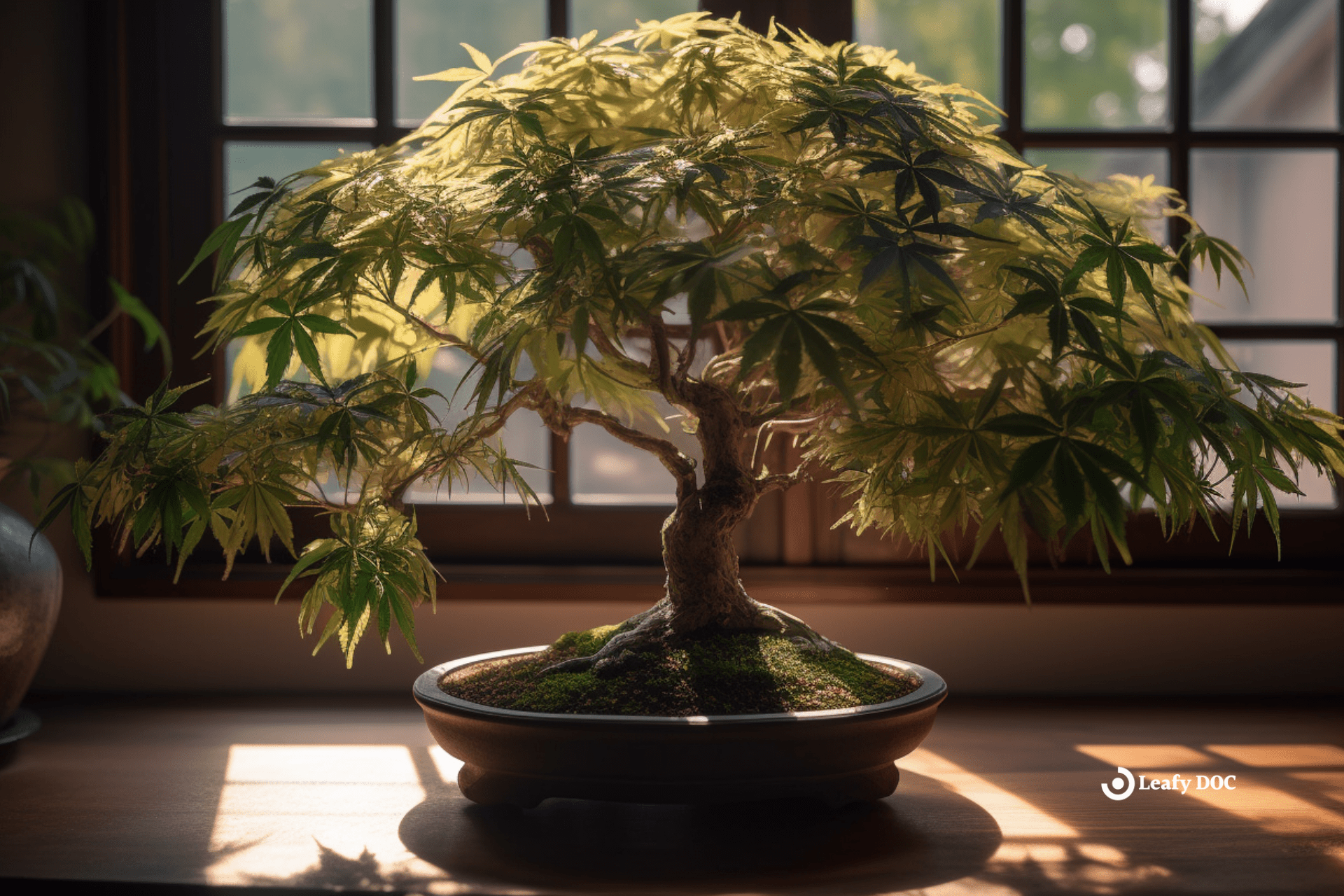How To Grow and Maintain a Cannabis Bonsai
by Haley Mills · November 14, 2023
Discover the art of growing and maintaining a stunning cannabis bonsai with our expert tips! Learn how to cultivate this miniature masterpiece and create your own bonsai marijuana tree. Click here to unlock the secrets now!

Cannabis bonsai is a unique and fascinating way to cultivate and showcase the beauty of the cannabis plant. By carefully shaping and pruning the plant, you can create a miniature version of a full-sized cannabis tree, complete with dense foliage and intricate branching patterns. However, growing and maintaining a cannabis bonsai requires a deep understanding of the plant’s needs and characteristics.
In this article, we will explore the steps and techniques involved in growing and maintaining a cannabis bonsai, from selecting the right strain to pruning and shaping techniques, to proper watering and nutrient management.
Choosing the right cannabis strain is an essential first step in successfully growing a cannabis bonsai. Not all cannabis strains are suitable for bonsai growth, as some may not respond well to the pruning and shaping techniques required. It is crucial to select a strain that is known for its compact growth and adaptability to training and manipulation.
Key Takeaways
- Choosing the right strain and understanding the plant’s needs is crucial for successful cannabis bonsai cultivation.
- Proper pruning and shaping techniques are important for achieving the desired form of the bonsai tree.
- Regular inspections and preventative measures should be taken to prevent pest infestations and diseases.
- Proper watering, light exposure, and nutrient management are essential for the health and vitality of the cannabis bonsai.
Choosing the Right Cannabis Strain for Bonsai Growth
When it comes to selecting the perfect strain for bonsai growth, it’s essential to consider the light requirements for cannabis bonsai growth. Cannabis plants require a significant amount of light to thrive, so choosing a strain known for its ability to tolerate high intensity light is crucial. Look for strains specifically labeled as suitable for indoor or greenhouse cultivation, as these varieties are typically more adaptable to the controlled lighting conditions necessary for bonsai growth.
In addition to understanding the light requirements, managing temperature and humidity is also essential for the success of your cannabis bonsai. Cannabis plants thrive in a specific range of temperature and humidity levels, so it’s crucial to choose a strain that can withstand the conditions in your growing space.
Optimal temperature for cannabis bonsai growth is around 70-85 degrees Fahrenheit during the day and 60-70 degrees Fahrenheit at night. Humidity levels should be kept between 40-60% to prevent mold and mildew growth. Some strains are more resilient to temperature and humidity fluctuations than others, so it’s important to research and select a strain that is known to perform well in the conditions you can provide.
Selecting the Ideal Container and Soil
When choosing the perfect container for your cannabis bonsai, imagine a small, intricately designed pot that complements the delicate beauty of the plant. However, aesthetics shouldn’t be the only consideration when selecting a container for your bonsai. Proper drainage is of utmost importance in bonsai container selection. The container should have several drainage holes at the bottom to prevent water from accumulating and causing root rot. Without adequate drainage, excess water can drown the roots and lead to the death of the plant.
Additionally, the container should be slightly larger than the rootball to allow for future growth and development of the cannabis bonsai.
In addition to proper drainage, the role of soil composition plays a crucial role in promoting healthy cannabis bonsai growth. Bonsai soil should be well-draining and provide adequate aeration to the roots. It should be a mixture of organic and inorganic components to strike the right balance of moisture retention and drainage. Organic components such as peat moss or coconut coir help to retain moisture, while inorganic components like perlite or pumice improve drainage. The soil should also have a slightly acidic pH level, ideally around 6.0 to 6.5, to support optimal nutrient absorption.
Pruning and Shaping Techniques for Bonsai Form
To achieve the desired bonsai form, you’ll need to employ effective pruning and shaping techniques. When it comes to training methods for cannabis bonsai, there are several options to consider.
One popular technique is known as “wiring.” This involves carefully wrapping wire around the branches of the bonsai tree to encourage them to grow in a specific direction. The wire should be applied gently, avoiding any damage to the branches. Over time, as the branches grow, the wire can be adjusted or removed. This method allows for precise control over the shape and structure of the bonsai tree.
Another training method for cannabis bonsai is called “clip and grow.” This technique involves pruning the tree branches to encourage new growth in specific areas. By selectively removing certain branches, you can create a more compact and balanced shape.
Pruning should be done during the appropriate time of year to ensure optimal bonsai growth. This leads us to the second keyword, pruning schedules. Pruning cannabis bonsai should typically be done in the late winter or early spring, when the tree is dormant. This allows the tree to recover and heal before the growing season begins. Be sure to follow proper pruning techniques, such as making clean cuts and avoiding excessive pruning, to maintain the health and vigor of the bonsai tree.
Proper Watering and Nutrient Management
For successful growth and health of your cannabis bonsai, it’s crucial to master the art of watering and nutrient management. Proper watering is essential to ensure that your bonsai receives the right amount of moisture without becoming waterlogged or dried out.
When watering your cannabis bonsai, it’s important to water thoroughly until you see water draining from the bottom of the pot. This ensures that the entire root system is adequately hydrated. However, it’s equally important to allow the soil to dry out slightly between waterings to prevent overwatering, which can lead to root rot and other issues.
In addition to watering, nutrient management is also crucial for the health and vitality of your cannabis bonsai. Providing the proper nutrients in the right amounts is essential for optimal growth and development.
One factor to consider is the importance of light exposure for your cannabis bonsai. Cannabis plants require a significant amount of light to thrive, and insufficient light exposure can result in stunted growth and poor health. It’s essential to place your bonsai in a location where it can receive at least 6-8 hours of direct sunlight or provide supplemental grow lights if necessary.
When it comes to fertilizing your cannabis bonsai, try to avoid common mistakes that can harm your plant. One common mistake is over-fertilizing, which can lead to nutrient burn and other issues. Follow the recommended dosage instructions for your chosen fertilizer and to monitor your plant’s response closely.
Another mistake to avoid is using the wrong type of fertilizer. Cannabis bonsai plants require a balanced fertilizer with a ratio of nitrogen, phosphorus, and potassium (NPK) that is suitable for their growth stage. Choose a fertilizer specifically formulated for cannabis plants and to adjust the NPK ratio as needed throughout the different stages of growth.
By mastering the art of watering and nutrient management, you can ensure the successful growth and maintenance of your cannabis bonsai.
Maintaining Healthy and Disease-free Cannabis Bonsai
Ensure your cannabis bonsai remains healthy and free from diseases by implementing proper care and regular inspections. One of the most important aspects of maintaining a healthy cannabis bonsai is preventing pest infestations.
Common pests that can affect cannabis bonsai include spider mites, aphids, and whiteflies. These pests can cause damage to the leaves and stems of the bonsai and can even lead to the spread of diseases. To prevent pest infestations, inspect your bonsai for any signs of pests regularly. Look for small webs, yellowing leaves, or tiny insects on the leaves. If you notice any of these signs, immediately eliminate the pests.
This can be done by using organic insecticides or by manually removing the pests from the leaves. Additionally, it’s important to keep your bonsai clean and free from debris, as this can attract pests.
In addition to preventing pest infestations, it’s also vital to troubleshoot common bonsai issues to maintain the health of your cannabis bonsai. One common issue is overwatering, leading to root rot and fungal diseases. To prevent overwatering, make sure only to water your bonsai when the top inch of soil is dry.
Another common issue is under watering, which can cause the leaves to wilt and turn yellow. To prevent under watering, make sure to water your bonsai thoroughly and evenly, allowing the water to soak into the soil. Other common issues include nutrient deficiencies and improper pruning.
To troubleshoot these issues, regularly monitor the health of your bonsai and make any necessary adjustments to your care routine. By implementing these preventative measures and troubleshooting common bonsai issues, you can ensure that your cannabis bonsai remains healthy and disease-free.
Frequently Asked Questions
Can I use any cannabis strain for bonsai growth?
You should choose a cannabis strain that has a compact growth pattern and smaller leaves, as these are more suitable for bonsai cultivation. Additionally, consider using a pot with good drainage and a size that allows for root development.
How often should I repot my cannabis bonsai?
The optimal pot size for cannabis bonsai growth varies depending on the strain and desired size of the plant. However, it is generally recommended to repot every 1-2 years to ensure proper drainage and prevent root-bound issues.
What are some common mistakes to avoid when pruning and shaping a cannabis bonsai?
When pruning and shaping a cannabis bonsai, it is important to avoid common mistakes. Proper lighting techniques, such as providing the right spectrum and intensity, are crucial for its growth. Additionally, maintaining humidity levels through misting and using a humidity tray can ensure a healthy bonsai.
Is it necessary to use specialized bonsai soil for growing cannabis bonsai?
Using specialized bonsai soil is not necessary for growing cannabis bonsai, but it can provide better drainage and nutrient retention. The importance of proper lighting cannot be overstated, as it directly affects the growth and development of the plant. Additionally, using proper training and wiring techniques is crucial for shaping and maintaining the desired form of the bonsai.
What are some common diseases that can affect cannabis bonsai and how can I prevent them?
Common pests that can affect cannabis bonsai include spider mites, aphids, and fungus gnats. To deal with them, you can use insecticidal soap or neem oil. Proper watering techniques, such as allowing the soil to dry out between waterings, can help prevent overwatering.
Last Updated: August 8, 2024
Get Approved for Your Medical Marijuana Card in Minutes!

Get Your Medical Card
Connect with a licensed physician online in minutes

Like This Article?
Share with your friends
Table of Contents
Keep Reading
-
Find Oklahoma Medical Marijuana Doctors Near You: A Step-by-Step Guide
Locate qualified Oklahoma medical marijuanas doctors near you with this comprehensive guide.
-
4 Steps to Find Texas Medical Marijuanas Doctors Near Me
Find qualified Texas medical marijuanas doctors near you with ease and ensure proper care.
-
Relax And Recover: CBD For Post-Exercise Bliss
Unwind and rejuvenate with CBD for post-exercise relaxation. Learn how CBD can enhance your recovery process and bring you ultimate bliss after a workout. Click here to discover the key to post-exercise tranquility!



